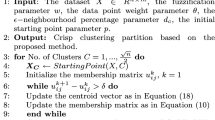Abstract
In this paper, a Complementary Fuzzy Support Vector Machine (CMTFSVM) technique is proposed to handle outlier and noise in classification problems. Fuzzy membership values are applied for each input point to reflect the degree of importance of the instances. Datasets from the UCI and KEEL are used for the comparison. In order to confirm the proposed methodology, 40 % random noise is added to the datasets. The experiment results of CMTFSVM are analysed and compared with the Complementary Neural Network (CMTNN). The outcome indicated that the combined CMTFSVM outperformed the CMTNN approach.
Access this chapter
Tax calculation will be finalised at checkout
Purchases are for personal use only
Similar content being viewed by others
References
Twala, B.: Impact of noise on credit risk prediction: does data quality really matter? J. Intell. Data Anal. 17, 1115–1134 (2013)
Ang, E., Kwansnick, S., Bayati, M., Plambeck, E.L., Aratow, M.: Accurate emergency department wait time prediction. J. Manufact. Serv. Oper. Manage. 18, 141–156 (2015)
Sessions, V., Valtorta, M.: The effects of data quality on machine learning algorithms. In: The 11th International Conference on Information Quality (ICIQ-06) (2006)
López, V., et al.: An insight into classification with imbalanced data: empirical results and current trends on using data intrinsic characteristics. Inf. Sci. 250, 113–141 (2013)
Zhu, X., Wu, X.: Class noise vs. attribute noise: a quantitative study of their impacts. J. Artif. Intell. Rev. 22, 177–210 (2004)
Garcia, L.P.F., Lorena, A.C., Carvalho, A.C.P.L.F.: A study on class noise detection and elimination. In: The 2012 Brazilian Symposium on Neural Networks (SBRN), pp. 13–18. IEEE, Curitiba (2012)
Sluban, B., Gamberger, D., Lavra, N.: Advances in class noise detection. In: 19th European Conference on Artificial Intelligence, pp. 1105–1106. IOS Press, The Netherlands (2010)
Verbaeten, S., Van Assche, A.: Ensemble methods for noise elimination in classification problems. In: Windeatt, T., Roli, F. (eds.) Multiple Classifier Systems, vol. 2709, pp. 317–325. Springer, Heidelberg (2003)
Jeatrakul, P., Wong, K.W., Fung, C.C.: Using misclassification analysis for data cleaning. In: International Workshop on Advanced Computational Intelligence and Intelligent Informatics (2009)
Lee, G.H., Taur, J.S., Tao, C.W.: A robust fuzzy support vector machine for two-class pattern classification. Int. J. Fuzzy Syst. 8, 76–86 (2006)
Jeatrakul, P., Wong, K.W., Fung, C.C.: Data cleaning for classification using misclassification analysis. J. Adv. Comput. Intelligence Intell. Inform. 14, 297–302 (2010)
Jing, R., Zhang, Y.: A view of support vector machines algorithm on classification problems. In: International Conference on Multimedia Communications (MEDIACOM), pp. 13-16, Hong Kong (2010)
Batuwita, R., Palade, V.: FSVM-CIL: fuzzy support vector machines for class imbalance learning. IEEE Trans. Fuzzy Syst. 18, 558–571 (2010)
Lin, C.-F., Wang, S.-D.: Fuzzy support vector machines. IEEE Trans. Neural Netw. 13, 464–471 (2002)
Samma, H., Lim, C.P., Ngah, U.K.: A hybrid PSO-FSVM model and its application to imbalanced classification of mammograms. In: Selamat, A., Nguyen, N.T., Haron, H. (eds.) ACIIDS 2013, Part I. LNCS, vol. 7802, pp. 275–284. Springer, Heidelberg (2013)
Ramyachitra, D., Manikandan, P.: Imbalanced dataset classification and solutions: a review. Int. J. Comput. Bus. Res. (IJCBR) 5(4), 1–29 (2014)
Lichman, M.: UCI Machine Learning Repository. University of California, Irvine, School of Information and Computer Sciences (2013)
Alcalá-Fdez, J., Fernandez, A., Luengo, J., Derrac, J., García, S., Sánchez, L., et al.: KEEL data-mining software tool: data set repository, integration of algorithms and experimental analysis framework. J. Multiple-Valued Logic Soft Comput. 17, 255–287 (2011)
Author information
Authors and Affiliations
Corresponding author
Editor information
Editors and Affiliations
Rights and permissions
Copyright information
© 2016 Springer International Publishing AG
About this paper
Cite this paper
Pruengkarn, R., Wong, K.W., Fung, C.C. (2016). Data Cleaning Using Complementary Fuzzy Support Vector Machine Technique. In: Hirose, A., Ozawa, S., Doya, K., Ikeda, K., Lee, M., Liu, D. (eds) Neural Information Processing. ICONIP 2016. Lecture Notes in Computer Science(), vol 9948. Springer, Cham. https://doi.org/10.1007/978-3-319-46672-9_19
Download citation
DOI: https://doi.org/10.1007/978-3-319-46672-9_19
Published:
Publisher Name: Springer, Cham
Print ISBN: 978-3-319-46671-2
Online ISBN: 978-3-319-46672-9
eBook Packages: Computer ScienceComputer Science (R0)




